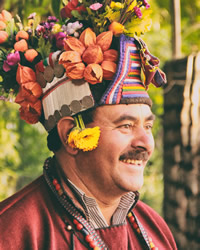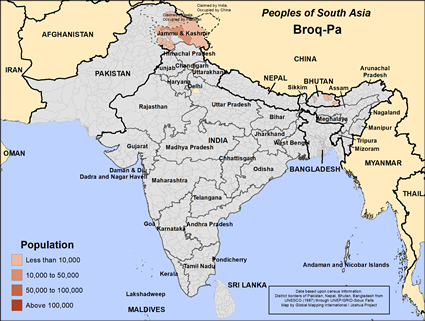Broq-Pa in Pakistan

Photo Source:
Sunny Tank - Unsplash
Creative Commons
|

Map Source:
People Group data: Omid. Map geography: UNESCO / GMI. Map Design: Joshua Project
|
| People Name: | Broq-Pa |
| Country: | Pakistan |
| 10/40 Window: | Yes |
| Population: | 6,000 |
| World Population: | 60,800 |
| Primary Language: | Brokskat |
| Primary Religion: | Buddhism |
| Christian Adherents: | 0.00 % |
| Evangelicals: | 0.00 % |
| Scripture: | Portions |
| Ministry Resources: | No |
| Jesus Film: | No |
| Audio Recordings: | Yes |
| People Cluster: | South Asia Tribal - other |
| Affinity Bloc: | South Asian Peoples |
| Progress Level: |
|
Introduction / History
Broq-Pa people live in northern India, along the Indus River in Ladakh and Kargil districts of the state of Jammu and Kashmir. Their villages are named Garkun, Darchik, Chulichan, Gurgurdo, Batalik and Da. They formerly lived in Hanu village as well, but now no Dokhpa people appear to live there. There is also a small number of Broq-Pa living in Pakistan-controlled Kashmir.
The official classification of the Broq-Pa in India appears to include three sub-ethnicities: the Brokpa, Dard and Shin. The Broq-Pa should not be mistaken for other similarly named groups in the Himalayan Region, including the Drokpa people of Nepal and the Broq-Pa of Bhutan. Broq-Pa is a name also given to this group by the Ladakhi people.
The Broq-Pa language is called Brokskat. It is part of the Shina branch of the Indo-European linguistic family— the only one of the seven Shina languages that is spoken in India. Five of the Shina languages are spoken in Pakistan and one in Afghanistan. This linguistic link confirms the suspicions of K S Singh, that the Broq-Pa 'are the descendants of the Dards and have migrated from Gilgit. The history of their migration is preserved in their folk literature. '
What Are Their Lives Like?
Although they live in the same area as the Ladakhi, the Broq-Pa are distinguished by their linguistic differences and by appearance. The Broq-Pa 'wear headgear and a gown, the former being decorated with flowers, beads, needles, ribbons and buttons. Both men and women are particularly fond of flowers. Women style their hair in plaits while men shave the front portion of the head and have a long pigtail. The men and women cover their body with goat skin, lined inside with fur.' The main staple food of the Broq-Pa is roasted barley flour, called sattu. Certain foods, such as beef, cow's milk, birds and eggs, are strictly taboo because of religious and superstitious beliefs.
What Are Their Beliefs?
While all the closest ethnolinguistic relatives of the Broq-Pa people are Muslims living in Pakistan and Afghanistan, most Broq-Pa in India follow the Tibetan Buddhist religion. 'The deities worshipped by them are La, Dogla and Sapdak, to whom animal sacrifices are offered. They also believe in demons.... Marriage ceremonies are conducted by the Buddhist priest, the lama, at the bride's place. When a death occurs, the lama is called upon to assist the chief mourner to conduct the funeral rites. The dead are cremated in a lying posture and a member of the clan lights the funeral pyre. The remains of the bones and ashes are buried.' Smaller numbers of Broq-Pa people follow their traditional animistic religion, while a few have converted to Islam.
What Are Their Needs?
Few Broq-Pa people have ever been exposed to the gospel. Although there are more than 200 Christians among the neighboring Ladakhi, few if any are engaged in sharing their faith.
Prayer Points
Pray that the Broq-Pa in Pakistan will put their faith in the guidance of Jesus Christ.
Pray for the Lord to thrust out loving and dedicated workers to the Broq-Pa people.
Pray for a movement to Christ among them to come soon.